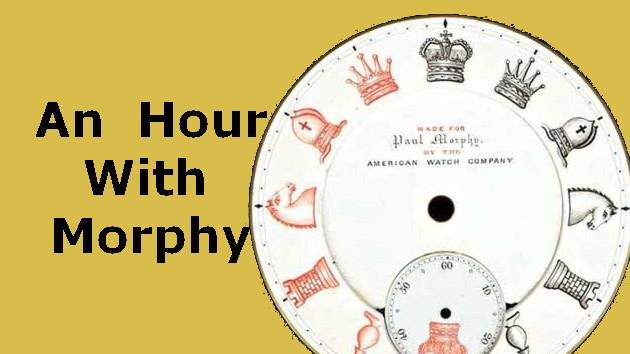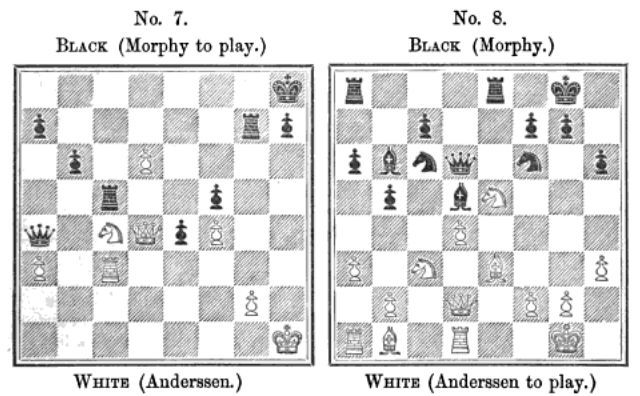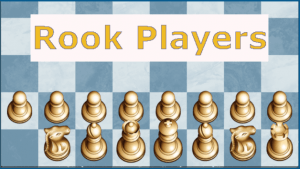
An Hour With Morphy
This article was published in the "British Chess Magazine" three months after Paul Morphy's death. It was obviously written as a memorial to Morphy and meant to showcase his genius as well as an attempt to explain his winning techniques. The one thing that caught my eye wasn't so much the content, but the difficulty of a modern reader to wade through it all, a daunting task requiring setting up a board for each example and trying to follow the descriptive notation. I decided to try to make the article more "user accessible" by finding the games from which the positions were extracted, putting them in viewers, by transposing the descriptive to algebraic in the text and by altering the formatting.


Of Morphy as a Chess-player there is nothing but good to be said. He had his detractors, as a matter of course. Staunton did his best to find fault with him. Anderssen is reported to have said (notwithstanding a majority of seven match games to two in favour of Morphy), "I never, even in my dreams, believed Morphy my superior in play." More recently, certain writers have intimated that if such a thing could happen as a match between certain living players and Morphy we should see what we should see! Who believes them? The ponderous games of the modern school have their day and then sink into forgetfulness, while Morphy's have become "classical," and stand in the front rank, with a few of Anderssen's and the best of those played between McDonnell and Labourdonnais—a joy for ever. "A brilliant Chess gem," says Mr. Minchin, "will always rouse the enthusiasm of the devotees of the game beyond the exhibition of the highest Chess strategy ever witnessed."
Staunton's annoyance that Morphy should attain a position in the Chess world superior to himself is amusingly displayed in the language he uses. He comments upon "Morphy's adulators," "critics who affect to fall into ecstasies at the most ordinary move Morphy makes." He is occasionally quite wroth with Morphy's opponents for their "stupendous blunders" and "frightful oversights"—aiming chiefly at Lowenthal. His attempts at disparagement, like those "gestures of dissent and disapprobation" deprecated by Sergeant Buzfuz, have survived to "recoil on the head of the attempter." Had he been aware of the fate fortune had in store for Morphy he would no doubt have been less ungenerous. Nevertheless he hit upon one of the secrets of Morphy's success in bringing forward the fact, since confirmed in every grand tournament, that there is no lack of weak spots in the play of the first masters—positions in which a win may be forced by a player as expert in the art as numerous problem solvers are in the art of discovering a mate. Such an expert was Morphy. In playing with him his opponents, knowing that a very slight mistake would be fatal to them, lost nerve, and did various unaccountable things. "In my own opinion," says Anderssen, "I was perfectly collected, but still I overlooked the most obvious moves." Yet Anderssen endured to the end better than either Lowenthal or Harrwitz. His tenth game (the last but one) was considered "one of the best played games in the match." It was won by Anderssen after 77 moves.

Who, except Morphy, looking at the accompanying position (Game No. 1) would hit upon the splendid combination that arises from (Black) 16...Rb8 17.O-O-O Rxf2 18.Bxf2 Qa3 &c.! A double sacrifice clears the ground for a diagonal attack.
This idea was not born of Morphy's brain fully accoutred. It had a natural—albeit tropical—growth and development, and was the product of good practice and a tenacious memory. The idea of exchanging the Rook for an opposing Kt, B, or P, when opportunity justifies, is part of the programme initiated by the advance of the f pawn, a move which as Loewenthal points out Morphy always played as soon as possible after castling. The attack on the Queen's side, with Q and R, when his opponent castled with Q R, was one of his stock ideas. In one of his early games with his uncle Ernest Morphy the latter combination appears in a more primitive form (see Game No. 2). Morphy (White) plays 5. Ba6 Na5 16. Rec1 Bc6 17. Qxa5 bxa6 18. Qxa6+ Kd7 19. Rxc6 ! Qf5 20. Rxc7+ Ke8 21. Qc6+ Qd7 22. Rb8 Qxc6 and White mates in three moves.
This idea was not born of Morphy's brain fully accoutred. It had a natural—albeit tropical—growth and development, and was the product of good practice and a tenacious memory. The idea of exchanging the Rook for an opposing Kt, B, or P, when opportunity justifies, is part of the programme initiated by the advance of the f pawn, a move which as Loewenthal points out Morphy always played as soon as possible after castling. The attack on the Queen's side, with Q and R, when his opponent castled with Q R, was one of his stock ideas. In one of his early games with his uncle Ernest Morphy the latter combination appears in a more primitive form (see Game No. 2). Morphy (White) plays 5. Ba6 Na5 16. Rec1 Bc6 17. Qxa5 bxa6 18. Qxa6+ Kd7 19. Rxc6 ! Qf5 20. Rxc7+ Ke8 21. Qc6+ Qd7 22. Rb8 Qxc6 and White mates in three moves.

The next position (Game No. 3) is another form, and arose in a game with Loewenthal. Morphy (White) played 23. Rfc1 (threatening Rxb6) Qf6 24. Qe3 Ng4 25. Nxb6+ axb6 26. Rc7+ Kd8 27. Qxb6 Qxf2+ 28. Qxf2 Nxf2 29. Ra7 and wins.
Apart from show positions Game No. 4 leads to a useful study. The position occurred in the 7th game of the match with Harrwitz. The latter had won two games and lost four, so that he would be playing his best to equalize. He had, however, lost confidence, and showed already symptoms of his forthcoming indisposition. He (White) plays 11.f4, which Loewenthal condemns, and adds "on principle it is weak play, as it leaves a Pawn behind, unsupported, and in the particular instance before us, causes the position very quickly to turn in favour of the second player": 11.f4, 12. d5; "I now prefer the German's game," says Staunton in defiance of Loewenthal. Black has the choice of 12...exd5, 12...Bxc3, 12...Nd7, 12...Na6, and 12...Re8. Let the reader, if he pleases, pause here and select a move for himself. He will hardly fix upon the move chosen by Morphy 12...Na6 13. dxe6 Qxe6 14. Rae1 (!). Harrwitz's weakness comes in here. What will Morphy now play? Nc7, Rae8, Rad8, or Bh4 The last seems to lose time, and is likely to be passed over in consequence, but, as Loewenthal remarks, whether White, in reply, play Ng3, or g3 he gets a bad game. Here we have the germ of one of Morphy's winning combinations. Harrwitz is outplayed in an opening "with every variation of which he is thoroughly familiar." The idea is "losing a time to operate on the enemy's position." It leads ultimately to the gain of a Pawn with a superior position. The game was drawn by an oversight.

The rapid growth of Morphy's wins is shown in a game with Judge Meek (Game No. 5) Morphy (Black) plays 17...Re3 18. Qb5 c6 ! 19. Qf1 (mate n three moves if he takes the Knight) Bh3 ! 20. Qd1 Rf8 21. Nf3 Ke8 and wins.
Loewenthal supplies another example in his 14th game. (See Game No. 6). White had just played 16.Ng3 and Black unsuspectingly replied 16...Bxc2. "Far from judicious," says Staunton, drawing it " mild" on this occasion. 17. f4 g6; "Still worse," comments Staunton. 18. e6 ! "An admirable move," notes Loewenthal, "threatening to win a piece by Qc3, and so improving his position as to make the game in a manner his own." Black sacrifices a Pawn and obtains a divergent attack.
Loewenthal supplies another example in his 14th game. (See Game No. 6). White had just played 16.Ng3 and Black unsuspectingly replied 16...Bxc2. "Far from judicious," says Staunton, drawing it " mild" on this occasion. 17. f4 g6; "Still worse," comments Staunton. 18. e6 ! "An admirable move," notes Loewenthal, "threatening to win a piece by Qc3, and so improving his position as to make the game in a manner his own." Black sacrifices a Pawn and obtains a divergent attack.

Another form of this idea, not so obvious, occurs in a game with Anderssen. (Game No. 7.) Morphy (Black) plays 39.Rc3 e3 ("the only move") 40.Rxe3 (Qf6 draws) Rxc4 41.Qf6 Rc1+ 42.Kh2 Qxf4+ and wins.
It will easily be seen from the foregoing how naturally Morphy's combinations arose from his attention to the principle of development. Some players only begin to believe in it after much labour and many losses. Others mix it up with the constructive principle and lay the foundation for a pyramid when there is only time to erect a column. Morphy had it we are told "as if by inspiration." Loewenthal informs us that his early blunders were in a different direction —that he "used to get rid of his Pawns as quickly as possible, regarding them as incumbrances which prevented the free action of his pieces." He quickly corrected this fault. His men always seem ready to go where he wants them. Much of his success is due to this. It is as available for defence as for attack. (See Game No. 8.) Anderssen (White) played 20.Qc2 threatening to win a piece. Morphy replied 20. Nxd4 21.Bxd4 Bxd4! 22.Nxd5 Qxe5 23.Nxf6+ Qxf6 24.Qh7+ Kf8. By a counter attack, to which his system readily lends itself, Morphy has foiled Anderssen's "terrible attack," and "the position is reduced to an end.game of a simple character."

The idea of "attacking a reserve or supporting piece" is one that Morphy utilized in various ways. A striking instance is to be found in a game with an Amateur. (See Game No. 9.) Morphy plays 21. Re8!
Another illustration is presented in a game with Thompson. It is combined with the idea "divide and conquer." (See Game No. 10.) Morphy (Black) plays 16....Rad8 17. Neg5 Rxf3 18. Nxf3 Rd3 19. Qb2 Rxf3 &c.

Morphy's brilliant displays do not necessarily require a difficult or complicated position. As in Horwitz's end-games the problem how to win is none the less abounding in point by reason of there being few pieces on the board to manipulate. Loewenthal preferred this part of the game, but he broke down against Morphy like all the others.
The pretty position No. 11 is from a game with Barnes, whose play with Morphy led to several remarkable situations.
Morphy (White) had played Rd1, offering a Pawn, which Black at once accepted. 26...Qxf5 27.Qxf5 Rxf5 28.Rd7 Bf8 29.e6 , and Black is unable to stop the King's pawn from queening, except with the loss of a piece.
Perhaps the prettiest example of " advancing a Pawn to queen" arose in a game with Harrwitz. (See Game No. 12.) Harrwitz was a careful player more disposed for safety than show, but he now plays 38.Nc6+, letting himself in for the loss of his game by the continuation 38....Bxc6 39.dxc6 c2 40.Kd2 Rc3! This was Morphy's first success with Harrwitz, and after it the latter did not win another game. Morphy had taken his measure.
These illustrations deal with only one phase of Morphy's genius. They are perhaps sufficient to show how extremely simple, when examined, were the combinations with which he produced so many startling effects. He was, however, quite familiar with his weapons, and knew that his opponents had no better. It was sufficient for success to be one step in advance of his time but Morphy was more than that in exactitude, activity of mind, and breadth of view. Yet there were Chess ideas known in his time of which he made comparatively little use. Since then other combinations have come to the front and other methods of play, notably that adopted by Steinitz, which although "regrettably wanting in enterprise" is especially calculated to foil an attacking player playing a forward game. This was Morphy's style. He combined brilliancy with soundness. Later players, adopting his method, but without his skill, have contrived to make it less popular. "Zukertort," says Minchin, "has shown by his practice his belief that the defence has beaten the attack in all open games." The modern school of "strategy versus combination" consequently advocates soundness in preference to brilliancy. Why not both alike'! We not unfrequently find Chess writers associating brilliancy with unsoundness as if they were naturally connected—which is absurd. It is probable that no special fashion of play can long maintain a predominance. "Every year throws fresh light on the theory of Chess," said George Walker forty years ago. To adapt a thought from another writer, much that a leading player, cannot receive, or cannot fit into his own style, is taken up by others in opposition to himself, and a reaction takes place, weak at first and with little authority but finally victorious. Thus the spirit of Philidor, of Staunton, of Anderssen, or of Morphy becomes in time merely a single element in the formation of some more advanced style of play. It follows that there is yet scope for young and gifted players to astonish and delight the world. The sadness of Morphy's satiety is a caution against treating life like a gambit instead of a giuoco piano.
—Edward Freeborough
Below is Morphy's obituary from "The New Orleans Times-democrat," July 13, 1884.
The death of Paul Morphy has removed from our midst one who may justly be pronounced a true phenomenon of the present century ; for, however much it may be argued that genius consists of an infinite capacity for taking pains, we hold that this applies in truth only to talent, which, in its highest type, may sometimes attain even greater results than genius of a moderate type, but which ever remains only talent still. Genius, true genius, in the exercise of its powers can be limited by no such constrained definition. It acts through incomprehensible methods; it reaches its ends or conclusions by inexplainable means; it differentiates itself from talent by lines unmistakable yet indefinable in terms; it is in every sense and in every characteristic of its existence a true phenomenon. And Paul Morphy was a true phenomenon, for never before existed there so true, so unmistakable, so astounding a genius for the noble and intellectual game with which his name and his fame are indissolubly linked. Other great players had lived before him and transmitted their masterpieces to subsequent generations; other great players have come after him and claim to have discovered and recorded a new and more perfect school of Chess; but not one has ever approached him in that natural, innate capacity for the game and for every branch of it; in that complete possession of every faculty necessary for its practice and rendering him the nearest, if not, indeed, the only approximation to the perfect player.
Nor is this claim of superiority simply an empty assertion; the proofs lie in the nearly complete collections of his recorded games, collections embracing his every mood and manner of play, from the deeply meditated battle against a fellow giant of the Chess world to the hasty skirmish with a mere fourth-rate, and yet how weighty is the proof thus afforded ? What other Chess master could thus appear en deshabille, as it were, before the judges and stand a comparison? In what other player's games can we find such absence of dullness, such freedom from errors, such abundance of sparkling surprises, such wonderful blending of attack and defence, such profound, daring and subtle combinations, and above all such originality, such freshness—the truest indication of genius, after all? What Mozart, as to innate, natural ability, was to music, Morphy likewise was to Chess. He stands, in this characteristic, unique, alone, without a rival, however much in other respects his claims to pre-eminence may be disputed. For Morphy's rise to the front rank of Chess-players was not like that of Steinitz, or Anderssen, or Staunton, or Zukertort, or Blackburne, or any one of a dozen other masters—nay, even of Labourdonnais himself, the result of long years of serious study and practice with other great, and perhaps stronger, players than himself. As a very child, and (as his uncle Ernest Morphy writes to La Regence as far back as 1851) before he had ever opened a Chess work, he was a finished player, selecting the coups justes in the openings as if by inspiration! When he struck the kings of European Chess from their lofty thrones, it was not by virtue of the experienced strategy of a practised master, but by the sheer strength of an irresistible genius that rose equal to the requirements and superior to the difficulties of every occasion presented. Well might so profound a judge as Mr. Boden declare that the possibilities of Morphy's genius had never been half revealed because only a very limited exercise of its powers had been always sufficient to insure victory!
Indeed, the more searchingly we examine and compare with Morphy's the recorded masterpieces of the other kings of Chess, the stronger grows the conviction that no other ever lived whose capacity for the game from every standpoint was so truly gigantic, in whom, both mentally and even physically, so wonderful a union of every characteristic of the complete player was to be found. Coolness, patience, accuracy, perseverance, imagination, enterprise, daring, judgment, rapidity and facility of play, and memory of an astounding character, all were Morphy's, and all in a degree that no Chess master in the history of the game ever possessed before and that, we fear, in all likelihood none other will ever possess hereafter. And despite of all that the kings of the so-called modern school of Chess assert for it in the way of superiority over the old style, of which Morphy may be claimed to have marked the grand and final climax, who shall doubt for a moment that, if opposed to these, his stupendous genius would not have dashed aside ingloriously the too feeble net-work of counter-march and manoeuvre, and shattered their but seemingly impregnable positions with the lightning strokes of mighty and unfathomable combination ? We frankly confess that no such doubts exist for an instant with us.
Nor is this claim of superiority simply an empty assertion; the proofs lie in the nearly complete collections of his recorded games, collections embracing his every mood and manner of play, from the deeply meditated battle against a fellow giant of the Chess world to the hasty skirmish with a mere fourth-rate, and yet how weighty is the proof thus afforded ? What other Chess master could thus appear en deshabille, as it were, before the judges and stand a comparison? In what other player's games can we find such absence of dullness, such freedom from errors, such abundance of sparkling surprises, such wonderful blending of attack and defence, such profound, daring and subtle combinations, and above all such originality, such freshness—the truest indication of genius, after all? What Mozart, as to innate, natural ability, was to music, Morphy likewise was to Chess. He stands, in this characteristic, unique, alone, without a rival, however much in other respects his claims to pre-eminence may be disputed. For Morphy's rise to the front rank of Chess-players was not like that of Steinitz, or Anderssen, or Staunton, or Zukertort, or Blackburne, or any one of a dozen other masters—nay, even of Labourdonnais himself, the result of long years of serious study and practice with other great, and perhaps stronger, players than himself. As a very child, and (as his uncle Ernest Morphy writes to La Regence as far back as 1851) before he had ever opened a Chess work, he was a finished player, selecting the coups justes in the openings as if by inspiration! When he struck the kings of European Chess from their lofty thrones, it was not by virtue of the experienced strategy of a practised master, but by the sheer strength of an irresistible genius that rose equal to the requirements and superior to the difficulties of every occasion presented. Well might so profound a judge as Mr. Boden declare that the possibilities of Morphy's genius had never been half revealed because only a very limited exercise of its powers had been always sufficient to insure victory!
Indeed, the more searchingly we examine and compare with Morphy's the recorded masterpieces of the other kings of Chess, the stronger grows the conviction that no other ever lived whose capacity for the game from every standpoint was so truly gigantic, in whom, both mentally and even physically, so wonderful a union of every characteristic of the complete player was to be found. Coolness, patience, accuracy, perseverance, imagination, enterprise, daring, judgment, rapidity and facility of play, and memory of an astounding character, all were Morphy's, and all in a degree that no Chess master in the history of the game ever possessed before and that, we fear, in all likelihood none other will ever possess hereafter. And despite of all that the kings of the so-called modern school of Chess assert for it in the way of superiority over the old style, of which Morphy may be claimed to have marked the grand and final climax, who shall doubt for a moment that, if opposed to these, his stupendous genius would not have dashed aside ingloriously the too feeble net-work of counter-march and manoeuvre, and shattered their but seemingly impregnable positions with the lightning strokes of mighty and unfathomable combination ? We frankly confess that no such doubts exist for an instant with us.






